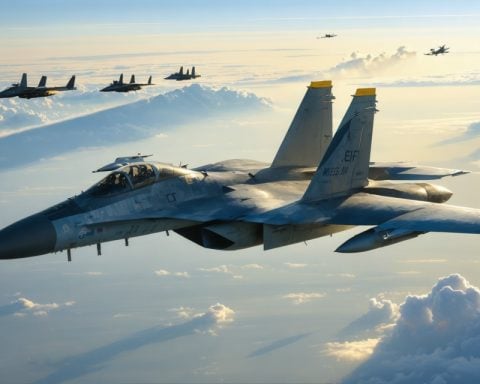- U.S. F-35s engaged with Russian Tu-95MS bombers and Su-35 fighters in the Alaskan ADIZ, emphasizing strategic aerial maneuvering without breaching U.S. or Canadian borders.
- Vivid imagery from the encounters highlights the close shadowing of Russian bombers by U.S. fighters, showcasing an intricate aerial interplay over the Bering and Chukchi Seas.
- The Russian Su-35 fighters displayed a formidable presence with R-77 and R-73 air-to-air missiles.
- U.S. aircraft used radar cross-section enhancers, sacrificing stealth for recognized safety in peacetime operations.
- These encounters reflect a strategic game of assessment and adaptation, with Russia regularly testing U.S. response tactics.
- The encounters highlight ongoing geopolitical dynamics, underscoring the potential for both conflict and communication in the skies.
The Alaskan skies seemed serene until the hum of engines shattered the icy silence, indicating a strategic ballet unfolding above. Recently, U.S. Air Force F-35s danced with Russian Tu-95MS bombers and Su-35 fighters in the expansive Alaskan Air Defense Identification Zone (ADIZ). These encounters, draped in international airspace, offered a spectacle of strategic maneuvering, without breaching the sovereign borders of the U.S. or Canada.
In a world where details often remain classified, the release of vivid imagery from these encounters captivates the imagination. Captured over the Bering and Chukchi Seas, these photos depict two powerful F-35A fighters closely shadowing the Russian bombers, showcasing an intricate aerial interplay. Armed with a striking arsenal, the Russian Su-35 Flanker-E fighters exhibited a formidable presence, each carrying R-77 and R-73 air-to-air missiles, glinting ominously in the sunlight.
While such interactions are not rare, the finesse of these operations lies in their precision and restraint. Notably, the U.S. aircraft exhibited reflective radar cross-section enhancers, relinquishing their stealth advantage for safety in this peacetime operation. This strategic choice ensures a controlled and recognized presence, all while maintaining an unspoken rule of peace in these sky-bound engagements.
These encounters underscore an ongoing game of assessment and adaptation. Russia’s frequent forays into the ADIZ aim to test U.S. response tactics, hinting at an invisible chessboard sprawling across the heavens. Although the latest encounter was calm, history reminds us of past skirmishes charged with tension and risk.
In an era of intricate geopolitical dynamics, these skyward spectacles remind us of the potential for both conflict and communication in our shared stratosphere. The delicate dance in the skies continues, each maneuver a calculated message, resounding in the vast expanse above.
Unveiling the Dance in the Skies: Strategic Operations Over Alaska
How-To Steps & Life Hacks: Understanding Aerial Interceptions
1. Initial Detection: Advanced radar systems detect foreign aircraft entering an Air Defense Identification Zone (ADIZ).
2. Identification: Fighter jets are scrambled to visually identify the intruding aircraft. In the recent incident, U.S. F-35s swiftly engaged with Russian Tu-95MS bombers and Su-35 fighters.
3. Escort and Shadowing: Pilots maintain a safe distance while maneuvering to shadow the aircraft, gathering intelligence on their purpose and armament.
4. Communication: Often, radio communication is established, reminding foreign pilots of their monitored status and proximity to sovereign airspace.
5. Conclusion and Withdrawal: Once aircraft leave the ADIZ, the intercepting jets return to base, ensuring territorial integrity was maintained.
Real-World Use Cases: Strategic Implications
– Air Defense Readiness: These encounters test air force readiness, helping refine tactics and response times.
– Geopolitical Signaling: By engaging in this aerial choreography, nations signal military presence and strategic capabilities.
Market Forecasts & Industry Trends
The market for advanced fighter jets like the F-35 is expected to grow due to increasing geopolitical tensions. According to a 2022 Forbes report, global military spending is anticipated to see a steady rise, driven by modernization programs.
Reviews & Comparisons
– F-35 Lightning II vs. Su-35 Flanker-E:
– F-35: Known for its stealth capabilities, advanced avionics, and versatility.
– Su-35: Praised for agility, weaponry options, and longer range, making it a formidable opponent.
Controversies & Limitations
– Radar Cross-Section Enhancers: The use of these devices by F-35s reduces stealth advantages but is vital for avoiding miscommunication in peacetime intercepts.
– Geopolitical Risks: These encounters, albeit carefully managed, have the potential to escalate if not handled with precision and restraint.
Features, Specs & Pricing
– F-35 Lightning II:
– Price: Approximately $80 million per unit.
– Features: Stealth, multirole capabilities, advanced electronic warfare systems.
– Su-35 Flanker-E:
– Price: Estimated at $83 million per unit.
– Features: High maneuverability, advanced avionics, superior armament payload.
Security & Sustainability
– Security: Constant monitoring and strategic intercepts safeguard airspace integrity.
– Sustainability: Modern fighters incorporate materials and technology that enhance fuel efficiency and reduce carbon footprints in defense sectors.
Insights & Predictions
The ongoing geopolitical chess game points to a future of heightened aerial maneuvers as nations strive to assert dominance while avoiding direct confrontation. The trend suggests an increased expenditure on advanced aircraft and defense systems.
Tutorials & Compatibility
– Training for Interceptions: Pilots undergo rigorous training, including simulation exercises, to perfect interception techniques and engage in unplanned aerial encounters effectively.
Pros & Cons Overview
– Pros:
– Enhanced national security and readiness.
– Opportunities for geopolitical communication without direct conflict.
– Cons:
– Potential for rapid escalation if miscommunications occur.
– High operational costs associated with frequent sorties.
Actionable Recommendations
1. Stay Informed: Follow credible defense news outlets for updates on air defense activities.
2. Understanding ADIZ Protocols: Familiarize with how ADIZ functions globally by exploring resources from defense organizations.
3. Support Peace Initiatives: Encourage diplomatic dialogue to lessen the need for such operations.
For more information and updates on defense and security, visit the Defense News website.








